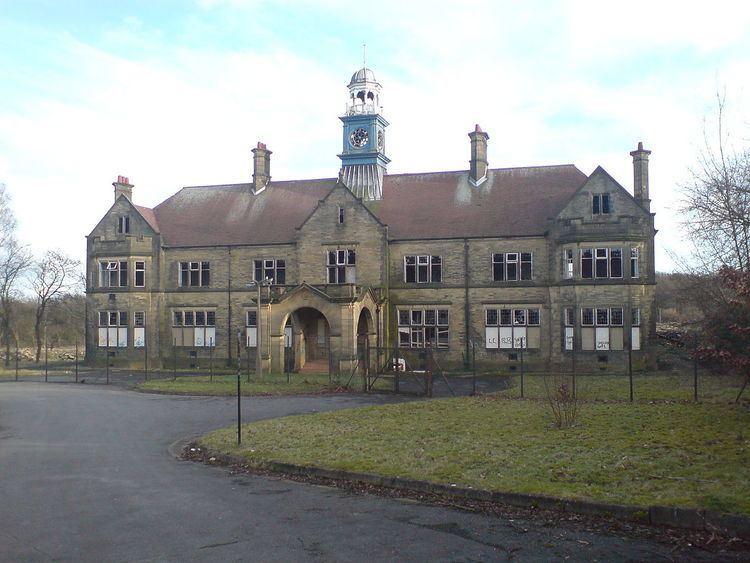Local time Tuesday 8:33 PM | ||
 | ||
Weather 11°C, Wind SW at 11 km/h, 79% Humidity | ||
Storthes Hall is a part of the township of Kirkburton, West Yorkshire, England. A heavily wooded area, it comprises a single road, Storthes Hall Lane, which links Kirkburton with the nearby villages of Farnley Tyas and Thurstonland. To the immediate north is North Spring Wood. Boothroyd Wood occupies the area to the south whilst Myers Wood can be found to the east. Myers Wood is the site of a medieval iron working site.
Contents
Psychiatric hospital
A psychiatric hospital operated at Storthes Hall between 1904 and 1991. Founded as an asylum and known as the Storthes Hall Mental Hospital (1929–1938), then as the West Riding Mental Hospital (1939–1948), and finally as the Storthes Hall Hospital (1949–1991). A book, Storthes Hall Remembered, written by a former nurse employed there tells the story of Storthes Hall.
Storthes Hall Mansion, built in about 1788 as a private house for the mill owning Horsefall family and located closer to Kirkburton centre, was converted into and asylum in 1904, renamed The Mansion Hospital and run independently as a hospital for people with learning disabilities. It closed in 1991 and was eventually converted back to a private residence. The Mansion is a Grade II listed Building. A book written in 1985(now out of print) by Douglas A Spencer on the Mansion was titled "Some Historical Records on the Mansion Hospital and Storthes Hall Hospital, Kirkburton, Huddersfield, West Yorkshire".
Storthes Hall Hospital was one of several hospitals investigated in 1967 as a result of the publication of Barbara Robb's book "Sans Everything". Accusations covered a thirty-two week period of serious violent assaults with fists or weapons against male patients of all ages, committed by four named male nurses. It was also alleged that it was like Belsen because it was a “brutal, bestial, beastly place”—it was a “hell-hole”.
Site
The area has some private housing, however the University of Huddersfield supplies most of the occupants in a campus, the Storthes Hall Park Student Village. Recent planning permission was granted to a retirement village on the remainder of the hospital site. The site previously provided training facilities to Huddersfield Town FC before their move to the recently developed state of the art Canalside facility off Leeds Road near the John Smith's Stadium.
Fate of hospital buildings
As of 2016 most of the hospital buildings on the Storthes Hall site have been reduced to rubble. Of the original buildings remaining, the former administration building is surrounded by fencing and barbed wire, whilst "the Arboretum" acts as the refectory and bar serving the student village and one of the blocks serves as the main entrance foyer and offices. The hospital's mortuary is still intact, as are several other smaller buildings. In 1998 the 46 wards and various non-residential blocks on the site were all still standing, and nearly all of these buildings were originally linked the site main boiler block via a system of interconnected subways and service ducts, through which various services including steam pipes for heating, electrical supplies and a main cold water main passed. The cold water main was fed from and underground reservoir which remains under a field at the top of Storthes Hall Lane, and a water treatment block remains on the south corner in the same area. The original borehole for the sites water supply is further up on Farnley Moor to the north of Greenside Road and is marked by a brick built square folly. Bore hole No.2 replaced this and this still remains at the lower part of Storthes Hall Road on the north side accessed by a track. Prior to demolition of the site the University of Huddersfield commissioned an asbestos survey which was carried out during 1991 / 1992. The asbestos survey was to the entire site and was carried out by Simon Farrar PCS Asbestos Consultants Limited as lead surveyor for Bradley Environmental Consultants Ltd. During the asbestos survey all buildings were inspected and photographs taken, which were probably the last visual record of the site prior to the programme of asbestos removal and then demolition of the majority of the structures. Asbestos lagging to pipes of up to 14 inch diameter fed steam and hot water from the main boiler room via the service tunnels and subways which then in turn fed heating the various blocks. Heating pipes ran mainly under the floors in voids to cast iron radiators and via rising ducts to the first floors where heating pipes were mainly surface mounted. Following closure of the site in 1991 the asbestos lagging quickly deteriorated once the steam had been turned off. The Acute Hospital Wards 1 to 10 at the lower part of the site were closed several years before and contamination spread within the ducts, subways and floor voids throughout the site. Asbestos removal works took 18 months with up to 50 operatives on site; the asbestos removal project was also managed through to completion by Simon Farrar. The asbestos removal works were carried out by LAR Ltd of Stockport.
